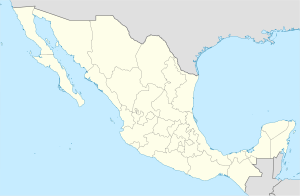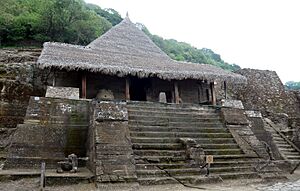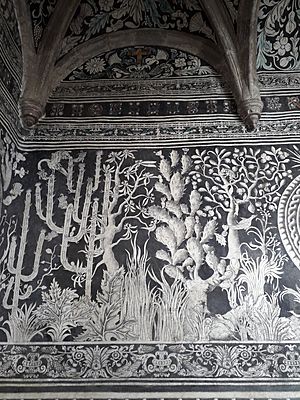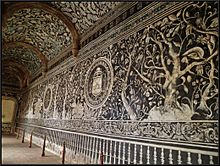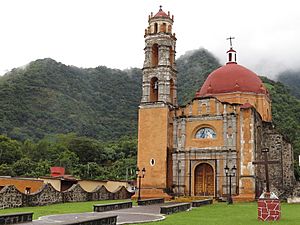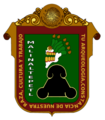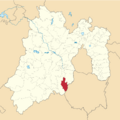Malinalco facts for kids
Quick facts for kids
Malinalco
|
||
|---|---|---|
|
Town & Municipality
|
||
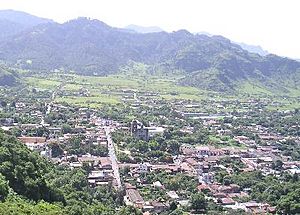
Panoramic shot of the town
|
||
|
||
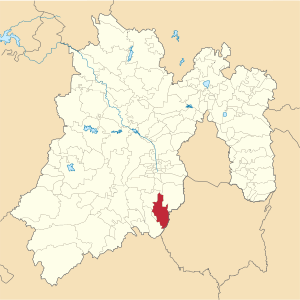 |
||
| Country | ||
| State | State of Mexico | |
| Founded | 12th century | |
| Municipal Status | 1826 | |
| Elevation
(of seat)
|
1,740 m (5,710 ft) | |
| Population
(2005) Municipality
|
||
| • Municipality | 22,970 | |
| • Seat | 6,523 | |
| Time zone | UTC-6 (Central (US Central)) | |
| • Summer (DST) | UTC-5 (Central) | |
| Postal code (of seat) |
52440
|
|
Malinalco is a charming town and municipality in the State of Mexico. It is located about 65 kilometers (40 miles) south of the city of Toluca. Malinalco is also about 115 kilometers (71 miles) southwest of Mexico City.
This area has long been linked to magic and ancient stories. One legend says it was once home to a powerful goddess named Malinalxóchitl. The municipality is also famous for the village of Chalma. Here, people believe a statue of a Black Christ appeared by magic in a cave. This cave was once used to worship an ancient god. Chalma is now the second most visited religious site in Mexico, after the Basilica of Our Lady of Guadalupe.
The Aztecs took control of Malinalco in the 1470s. They built a special place for their best fighters, the Eagle and Jaguar warriors. This important site is on a hill called Cerro de los Idolos (Hill of the Idols). The most amazing part is the Cuauhcalli, or House of Eagles. It's a building carved right into the side of the mountain!
The name Malinalco comes from the Nahuatl language. Malinalli is a type of grass, xóchitl means flower, and co means place. So, it means "where they worship the goddess Malinalxóchitl, the malinalli flower." The name also refers to a time period on the Aztec calendar. In ancient times, the area was shown with symbols of the malinalli plant or a human skull.
Unlike many other places in the State of Mexico, Malinalco does not use an Aztec symbol. Instead, it has a special logo designed in 1985. It shows the Mexican national seal with a mountain and a malinalli flower. The motto says: "Your archeology is the perseverance of our race, culture and work."
Contents
Exploring Malinalco's Geography
The town of Malinalco is the main center for 54 other communities. The whole municipality covers an area of 186.28 square kilometers (71.92 square miles). About 22,970 people live in the municipality, but only 6,523 live in the town itself.
Malinalco is about 1,750 meters (5,740 feet) above sea level. It sits between the Trans-Mexican Volcanic Belt and the Sierra Norte mountains. The northern parts are higher, with the Cerro de la Loma reaching about 2,700 meters (8,860 feet).
The main river is the Chalma River, also called the Ocuilan River. There are also many fresh-water springs like San Miguel and Ateopa. These springs provide drinking water for the communities. The weather is warm but not too hot, with most rain falling in the summer. The landscape is bright green in summer and golden in winter. Temperatures usually range from 20°C (68°F) in higher areas to 35°C (95°F) in lower ones. Higher elevations have pine forests, while lower areas have more tropical plants.
The San Miguel River flows through the town. Sadly, it has been used for dumping trash, which causes pollution and bad smells. This has made it harder for Malinalco to become a "Pueblo Mágico" (Magical Town). Plans are being made to clean up the river. This includes planting more trees, improving drainage, and stopping waste from entering the river. A recycling center has also been built to help manage trash.
Amazing Plants and Animals
Malinalco is home to a huge variety of plants and animals. It has tropical forests, pine forests, and riverside forests. You can find many mammals like civets, armadillos, foxes, coyotes, squirrels, and deer. Some experts even think jaguars might live here. There are also many insects, crustaceans, birds, and edible mushrooms.
While there are a few dangerous animals like coral snakes and rattlesnakes, they are rare. Many local myths tell stories about animals like the scorpion vinagrillo or the blue-tailed lizard. You can learn more about local species at the Living Museum "The Malinalco Bugs" and the Mali-Xanat turtle camp.
Malinalco's Rich History
Ancient stories say that the god Huitzilopochtli left his sister Malinalxóchitl in the forest because she practiced witchcraft. When she woke up, she was very angry. She gathered loyal followers and went to settle in what is now Malinalco. Another story says Malinalxóchitl led a group of people who left the Mexica tribe. They settled in Malinalco and mixed with the people already living there.
For a long time, Malinalco was seen as a magical place, full of gods and sorcerers. The area shows influences from the Teotihuacan and Toltec cultures, as well as the Matlatzincas and Aztecs. Not much is known about the area before the Aztecs arrived. The first settlements here date back to the early and late post-Classic periods. This was a time when many groups of people were moving around Mexico.
The Aztec Empire took control of this area in 1476 under their ruler Axayacatl. Later, another ruler named Ahuizotl built most of the Aztec shrines and temples, including the special fort for military elite.
When the Spanish arrived, the people of Malinalco fought back. Andrés de Tapia was sent to conquer Malinalco and Ocuilán. After the Spanish took control, the area was divided into encomiendas, which were like large estates.
The Franciscans and Dominicans were the first to try and convert the local people to Christianity. But it was the Augustinians who stayed and built a monastery. This monastery, first called San Cristobál, later became the Divino Salvador. After the monastery, smaller chapels were built in different parts of town. During the time of Spanish rule, a water system was built to use the natural springs.
The Jalmolonga Hacienda was a very important farm in the area. It was so productive that it helped support a college in Mexico City. When the Jesuits were expelled in the 18th century, this land was sold.
During the Mexican War of Independence, José María Morelos y Pavon visited Malinalco in 1813. He signed a document supporting local laws about farming. During the Mexican Revolution, Malinalco was mostly controlled by Zapatista forces.
Malinalco's Population and Lifestyle
Local Communities in Malinalco
| Populated places | Population |
| Total | 25,624 |
| Malinalco | 8,045 |
| San Simón el Alto | 2,643 |
| Chalma | 1,827 |
| San Andrés Nicolás Bravo | 1,535 |
| Jalmolonga | 1,019 |
Life in Malinalco Town
Malinalco town is nestled in a valley surrounded by cliffs. Most houses are made of adobe with red tile roofs, some painted in bright colors. Almost every house has fruit trees in its yard. The streets are paved with cobblestones, and you can still see donkeys carrying firewood.
Traditional breads are often baked in clay ovens. Homemade pulque, a traditional drink, is sold by street vendors. Malinalco's special food is trout. This dish became popular with the many visitors going to the nearby shrine of Chalma. Many restaurants serve trout in different ways: steamed, fried, or with garlic butter. Other local dishes include iguana, stewed rabbit, and tamales made with frog meat. The southern part of the municipality makes mezcal, while the north makes pulque.
In the town center, vendors sell delicious sherbets made from lime, sapote, mamey, and soursop. About 2 kilometers (1.2 miles) south of town is the El Molino trout farm. Here, you can pick your fish and have it cooked fresh. Between Malinalco and Chalma, there's another large trout farm. It might be the only one in the world that raises trout in cold mountain water under banana trees! A popular drink with meals is pineapple juice mixed with tequila, vodka, or mezcal.
Wednesday is market day, when vendors from nearby villages come to sell their goods. You can find local produce, traditional food, and beautiful wood carvings of animals and musical instruments. Malinalco has been named a "Pueblo con Encanto" (Town with Charm) by the state of Mexico.
At la Casa Mia, you can buy local handicrafts, especially colorful alebrijes.
Unique Stone Walls: Tecorrales
Malinalco has special stone walls called tecorrales. These walls are built without mortar, using dry-stacked stones. They are found all over the town and are a big part of Malinalco's history, going back to ancient times. Tecorrales help control erosion and create homes for plants and animals.
The word "tecorral" combines the Spanish word "corral" with the Nahuatl word "te." "Te" can mean "place" or even "sacred essence." This shows how important these walls are to the history and spirit of Malinalco, linking them to the goddess Malinalxóchitl.
While Malinalco still uses many traditional building styles, the old tecorrales give the town a unique look. Sadly, these ancient walls are slowly wearing away and need better protection.
An important example of how tecorrales are still part of local culture is the arts and community center called El Tecorral. It offers classes for kids and adults and hosts a popular green market on Saturdays. Artists are working to map the remaining tecorrales to help protect them.
Malinalco's Economy and Tourism
Even though Malinalco is in a busy part of Mexico, it is still very rural. It sits in a quiet valley with farms and forests. Most of the land is used for forestry, then fish farming, and then agriculture. However, farming is the most important job, with corn, flowers, and rice being grown. There is some livestock and very little industry. Trout farming is also a key part of the economy.
Most businesses focus on serving local people and tourists, especially in Malinalco and Chalma. About 63% of the people earn a living from farming, raising animals, and trout farming. Many families also work in other ways, like traveling to nearby cities or the United States for temporary jobs.
The most famous community outside of Malinalco town is Chalma. It is known for the Sanctuary of the Lord of Chalma, which is a statue of a crucified black Christ. Most people in Chalma work to help the many visitors who come all year.
According to legend, the Christ statue appeared by magic in a cave. This cave was where ancient people used to worship a god called Oxtoteotl. Visits to this Christian sanctuary still follow some old traditions. These include walking narrow paths, bathing in a special fresh-water spring, and dancing at the sanctuary. Near Chalma, there are large rocks that, according to legend, are people who turned to stone for disobeying the god.
Besides the Cerro de los Idolos, there are 35 other ancient sites in the municipality. These include places with cave paintings and petroglyphs (rock carvings), some of which are at least 2,000 years old. One well-known site is Las Caritas (The Little Faces), where small faces are carved into a cave wall. Two other sites with small cave paintings are Los Diablitos (The Little Devils) and El Coyotito Rojo (The Little Red Coyote).
Getting Around Malinalco
State roads connect Malinalco. One road goes from Chalma to Tenango del Valle. Another connects Malinalco with Tenancingo. There are also local roads that link Chalma with Miacatlán in the state of Morelos. In Chalma, there is a bus station with routes to Mexico City, Toluca, and Cuernavaca.
Malinalco's Culture and Landmarks
Important Historical Buildings
- The Sanctuary of the Lord of Chalma includes the church, a 17th-century former monastery, caves, and places for visitors to stay. The church has a Neoclassic design from its last updates. The entrance says: "Come to me all you who are working and tired and I will give you rest." Inside, there are many religious paintings and sculptures. The main attractions are the Christ of Chalma statue, a sculpture of Archangel Michael, and a painting of the Virgin of Guadalupe.
The most famous site is the Cuauhtinchan Archeological Zone. It is located west of town on the Cerro de los Idolos (Hill of the Idols), which is 215 meters (705 feet) above the town. This important Aztec site was found in 1933. The visible buildings date from the Aztec Empire, but the site was used for ceremonies much earlier. To reach the top, you must climb 426 stairs. Along the way, signs tell the area's history in Spanish, English, and Nahuatl.
The site has six buildings. The Cuauhcalli or House of the Eagles, built around 1501, is the main one. It is special because it is carved right out of the hill! This building looks like a pyramid with a flat top. The Cuauhcalli has been compared to famous sites like the Ellora Caves in India. It was a sacred place for the Eagle Warriors to perform rituals. A staircase with thirteen steps leads into the temple, guarded by two large cat sculptures. The Cuauhcalli has two rooms, one rectangular and one circular. The walls and ceiling were once covered in painted murals, but most are now gone. The entrance looks like the open jaws of a serpent with fangs and a forked tongue.
- The Temple and ex-monastery of the Divino Salvador was built between 1540 and 1560. This Augustine monastery was the center for spreading Christianity in the area. It is in the town center and looks medieval with thick walls. The church's front is simple but tall for a rural church. Inside the monastery, there are original 16th-century murals. These are early examples of "mestizo" art, made by local indigenous artists. On the first floor, the murals show the Garden of Eden story in an Aztec codex style. The monastery's courtyard is filled with medicinal and food plants. You can also find animals like monkeys and opossums.
- The Doctor Luis Mario Schneider University Museum is named after an Argentine writer who loved Malinalco. He lived there for 30 years and founded this museum. It has seven rooms that show Malinalco's geography, myths, and history. The permanent collection includes exhibits on festivals, the rainy season, and the House of the Eagle Warriors. The garden is a copy of the Cuauhcalli's garden.
- The Casa de Cultura or Cultural Center is in the town center, across from the Municipal Palace. It has copies of the murals from the archeological zone and old photos of local cultures. It also hosts dances, art shows, and other cultural events.
- The Tlakuikani Gallery shows modern art by artists from Malinalco and other parts of Mexico. It is in the Barrio de Santa Maria Norte and sells oil paintings and wood carvings.
Outside the town center, there are many small neighborhoods, each with its own chapel. Most of these chapels were built between the 16th and 17th centuries. Many, like those of Santa Maria, San Martin, San Guillermo, San Pedro, San Andres, and La Soledad, are considered works of art. For example, the chapel of San Juan has carvings of Augustine monks. Each chapel is unique and has its own special feast day.
Sports and Fun in Malinalco
The first sport played in Malinalco was football. The town even has a second-division football club called Colibríes de Malinalco. You can also find swimming pools and basketball courts.
The hills around Malinalco are used for grazing cows and sheep. In the past, Spanish landowners needed local people to work as vaqueros (cowboys). These local people quickly became skilled horse riders.
Malinalco is a popular place for tourists, with several nightclubs and places to visit on weekends.
Notable People from Malinalco
- José Maria de Yermo y Parres, a philosopher and Roman Catholic Saint, was born at the Xalmolonga hacienda in Malinalco.
Images for kids
-
Section of the fresco depicting the regional flora and fauna as well as the emblems of Jesus Christ, the Virgin Mary and the Augustinians.
See also
 In Spanish: Malinalco para niños
In Spanish: Malinalco para niños



